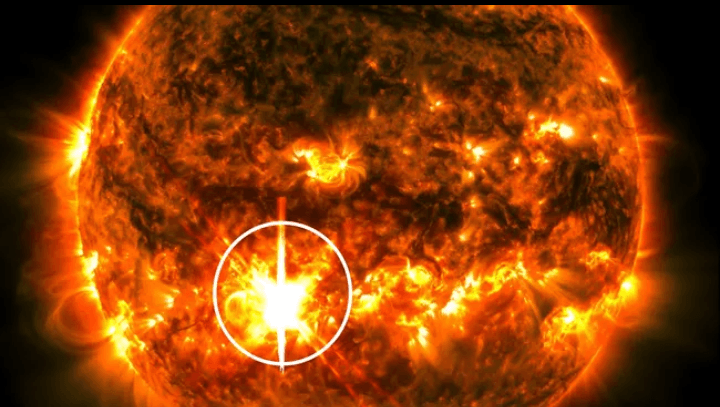
A Powerful Solar Storm Strikes Earth: What You Need to Know About the Recent Solar Explosion…
In a rare and dramatic event, the Sun has unleashed one of its largest solar flares in recent years, causing a temporary radio blackout on Earth and sending a massive coronal mass ejection (CME) hurtling toward our planet. This solar storm, which occurred on October 30, 2024, has attracted global attention as scientists closely monitor its effects. The storm’s impact is expected to continue into the weekend, with concerns ranging from communication disruptions to potential disruptions in GPS systems and power grids. In this article, we’ll explore what happened, what solar flares and CMEs are, how they affect Earth, and what to expect in the coming days.
What Happened: A Massive Solar Flare and CME
On October 30, 2024, the Sun emitted an exceptionally powerful solar flare a burst of intense radiation that travels through space at the speed of light. This solar flare was accompanied by a large coronal mass ejection (CME), a cloud of charged particles that exploded from the Sun’s corona (the Sun’s outer atmosphere) and was sent toward Earth.
Solar flares and CMEs are natural phenomena that occur on the Sun due to its dynamic magnetic field. When this magnetic field becomes twisted and tangled, it can release vast amounts of energy in the form of radiation (solar flares) or energetic particles (CMEs). In this case, the solar flare was classified as an X-class flare, the most powerful category of solar flare. X-class flares can cause temporary disruptions in communications and satellites, and if accompanied by a CME, they can also create geomagnetic storms when they interact with Earth’s magnetic field.
The CME, a massive eruption of plasma, was particularly notable for its size and speed. It was released at an incredible velocity and is expected to collide with Earth’s magnetosphere in the coming days, possibly leading to a geomagnetic storm. The interaction between the CME and Earth’s magnetic field can lead to auroras at high latitudes, but it can also disrupt technological systems and pose risks to satellites, communications, and power grids.
Solar Flares and CMEs: The Science Behind the Storms
Solar flares and CMEs are both products of the Sun’s highly active magnetic field. The Sun’s magnetic field is constantly shifting, and when these shifts become unstable, they can trigger flares and CMEs. Solar flares are classified by their intensity into three categories: A-class, B-class, C-class, M-class, and X-class, with X-class being the most powerful.
Solar flares release energy in the form of electromagnetic radiation, including X-rays and ultraviolet radiation. This radiation travels through space at the speed of light and can have a variety of effects when it reaches Earth. For example, X-rays from solar flares can ionize the Earth’s upper atmosphere, particularly the ionosphere, causing radio communication blackouts. The effects of a solar flare are usually temporary, but they can be particularly disruptive for aviation and space communication.
On the other hand, a coronal mass ejection is a massive burst of solar wind and magnetic fields rising from the Sun’s corona. These charged particles primarily electrons and protons can travel millions of miles per hour and, when directed toward Earth, interact with Earth’s magnetosphere, the protective bubble created by our planet’s magnetic field. If the CME is strong enough, it can induce geomagnetic storms, which are disturbances in Earth’s magnetic field.
While the immediate effects of a CME may not be visible to the naked eye, they can cause a variety of disruptions on Earth. These include interference with GPS systems, satellite malfunctions, power grid fluctuations, and increased radiation exposure for astronauts and high-altitude flights. More intense geomagnetic storms can even damage electrical infrastructure, especially in high-latitude regions closer to the poles, where the Earth’s magnetic field is weaker.
The Radio Blackout and Initial Impact
The solar flare on October 30 caused a temporary radio blackout, particularly affecting high-frequency (HF) radio signals. HF radio waves are crucial for aviation, maritime communications, and military operations. The X-class flare temporarily ionized the Earth’s ionosphere, which absorbed and scattered radio waves, leading to disruptions in radio communications over large portions of the globe. The blackout primarily affected the side of Earth facing the Sun at the time of the flare, but its effects were felt worldwide.
While these blackouts are usually short-lived, they can cause significant disruptions to communications systems that rely on HF radio, particularly during emergencies or critical operations. Satellite communication systems, which rely on the ionosphere for signal transmission, can also experience degraded performance during intense solar flares.
The Coronal Mass Ejection and Geomagnetic Storm
As the CME continues its journey toward Earth, scientists are closely monitoring its speed and trajectory. According to space weather experts, the CME is expected to hit Earth’s magnetosphere sometime this weekend, likely on November 9-10, 2024. When the charged particles in the CME collide with Earth’s magnetosphere, they can cause geomagnetic storms, which may disrupt satellite systems and affect GPS accuracy, especially at higher latitudes.
Geomagnetic storms occur when solar wind or CME particles interact with the Earth’s magnetic field, creating disturbances in the magnetosphere. These storms can lead to increased radiation exposure in space, which is a concern for astronauts and can affect satellites in orbit. Satellites may experience temporary malfunctions, and in some cases, solar storms can even permanently damage satellite electronics. Solar storms can also induce currents in electrical power grids, which, if not managed, could cause voltage instability and, in extreme cases, damage transformers.
While geomagnetic storms can also create spectacular auroras the colorful lights visible in the polar regions they can also disrupt the operation of critical infrastructure. Air travel in polar regions may also be affected due to radiation exposure concerns and communication challenges.
What to Expect This Weekend
Experts predict that the CME will likely cause moderate to strong geomagnetic storms when it collides with Earth’s magnetosphere this weekend. The storm’s intensity will depend on several factors, including the speed and density of the particles in the CME, as well as the orientation of the Sun’s magnetic field. If the CME is particularly intense, it could lead to more widespread disruptions in satellite communication, GPS systems, and power grids, particularly in high latitude regions.
At the same time, the storm is expected to create stunning auroras, which may be visible in places far beyond the typical aurora zones. If you’re in a location with clear skies and far from city lights, you may have the chance to witness this natural light show a silver lining to an otherwise disruptive event.
Preparing for Solar Storms
While solar storms are not a new phenomenon, they are a reminder of the Sun’s powerful influence on Earth’s environment. Scientists at space weather centers, such as NASA and the NOAA Space Weather Prediction Center, continue to monitor solar activity and provide forecasts and alerts. As the solar cycle progresses toward its peak in 2025, solar flares and CMEs are expected to become more frequent and intense.
Governments, industries, and space agencies are increasingly aware of the potential risks of space weather, and preparations are underway to mitigate the impact of solar storms on critical infrastructure. However, for now, most of the effects of solar storms on Earth are temporary and manageable. It’s a reminder of the dynamic relationship between our planet and the Sun and a call for continued vigilance in safeguarding our technological systems.
As the CME from October’s solar flare nears Earth, we can expect to see both the beauty and the challenges that come with such a powerful cosmic event. For those interested in space weather and its impact on our world, this solar storm offers a chance to learn more about the forces at play just beyond our atmosphere.






